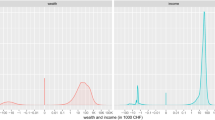Abstract
This paper studies the role of social insurance as a redistributive mechanism in presence of an optimal (linear or general) income tax. It considers a second-best setting with two unobservable individual characteristics: ability, measured by the wage rate and risk, measured by the probability of incurring a loss. It shows that both tax progressivity and the optimal level of social insurance crucially depend on the correlation between ability and risk.
Similar content being viewed by others
References
BlomqvistA. and H.Horn (1984) “Public health insurance and optimal income taxation,” Journal of Public Economics, 24, 352–371.
BoadwayR. and M.Keen, (1993) “Public goods, self-selection and optimal income taxation,” International Economic Review, 34 463–478.
Boadway, R. and M. Marchand (1995) “The use of public expenditures for redistributive puposes,” Oxford Economic Papers 45-59.
CremerH. and F.Gahvari (1995a) “Uncertainty and optimal taxation: In defense of commodity taxes,” Journal of Public Economics, 56, 291–310.
CremerH. and F.Gahvari (1995b) “Uncertainty, optimal taxation and the direct versus indirect tax controversy,” Economic Journal, 95, 1165–1179.
Cremer, H. and F. Gahvari, (1996), “In-kind transfers, Jself-selection and optimal tax policy,” (forthcoming) European Economic Review.
DiamondP.A., L.J.Helms and J.A.Mirrlees, (1980). “Optimal taxation in a stochastic economy: A Cobb-Douglas example,” Journal of Public Economics, 14, 1–29.
EatonJ. and H.S.Rosen (1980a), “Labor supply, uncertainty, and efficient taxation,” Journal of Public Economics, 14, 365–374.
EatonJ. and H.S.Rosen, (1980b), “Optimal redistributive taxation and uncertainty,” Quarterly Journal of Economics, 94, 357–364.
EatonJ. and H.S.Rosen (1980c) “Taxation, human capital, and uncertainty,” American Economic Review, 70, 705–715.
GuesnerieR. and K.Roberts, (1984) “Effective policy tools and quantity controls,” Econometrica, 52, 59–86.
MirrleesJ.A. (1990). “Taxing uncertain incomes,” Oxford Economic Papers, 42, 34–45.
RochetJ.-C. (1991). “Incentives, redistribution and social insurance,” The Geneva Papers of Risk and Insurance, 16, 143–165.
StiglitzJ.E., (1982) “Self-selection and Pareto efficient taxation, Journal of Public Economics, 17, 213–240.
StiglitzJ.E. 1987 “Pareto efficient and optimal taxation and the new new welfare economics,” Handbook of Public Economics Auerbach, A. and M. Feldstein, Amsterdam: North-Holland, 1991–1042.
VarianH.R., (1980) “Redistributive taxation as social insurance,” Journal of Public Economics, 14, 49–68.
Author information
Authors and Affiliations
Additional information
This paper has been prepared for the IIPF 51 st Congress held in Lisbon, August 21–24, 1995. The authors are grateful to F. Gahvari, M. Lundholm, M. Marchand, J.-C. Rochet, P. Sørenson and the referees for their comments.
Rights and permissions
About this article
Cite this article
Cremer, H., Pestieau, P. Redistributive taxation and social insurance. Int Tax Public Finan 3, 281–295 (1996). https://doi.org/10.1007/BF00418945
Issue Date:
DOI: https://doi.org/10.1007/BF00418945




